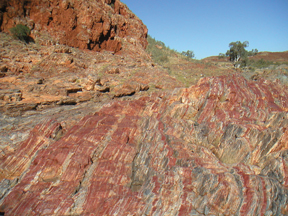|
News Notes
Early Earth
Airing out an early atmosphere
 Scientists have generally thought that oxygen was scarce in Earth’s atmosphere until about 2.4 billion years ago. A study based on new evidence from some of the oldest known rocks on Earth, however, is now challenging that consensus view, suggesting that oxygen may actually have been around longer than previously thought.
Scientists have generally thought that oxygen was scarce in Earth’s atmosphere until about 2.4 billion years ago. A study based on new evidence from some of the oldest known rocks on Earth, however, is now challenging that consensus view, suggesting that oxygen may actually have been around longer than previously thought.
Some of the oldest known rocks in the world are found in the Pilbara Craton of Western Australia, including the 3.46-billion-year-old Marble Bar Jasper. By drilling deep into other parts of the craton, scientists have recovered sediments that suggest Earth’s atmosphere had oxygen earlier than previously thought. Photograph is by Hiroshi Ohmoto and Yumiko Watanabe.
Many geologists consider an oxygen-free, or anoxic, atmosphere during the Archean — 3.8 to 2.5 billion years ago — to be the best explanation for a mysterious pattern of sulfur isotopes found only in some of Earth’s oldest rocks. The rocks contain a sulfur compound with an isotopic ratio that only can form when the rock is exposed to ultraviolet light. Today, the oxygen-rich ozone layer prevents the most intense ultraviolet light from reaching Earth’s surface. Therefore, many scientists reasoned that oxygen — and an ozone layer — would have to be largely absent from the atmosphere to allow that widespread isotopic signature to form.
Not all Archean rocks show these unusual signatures or support the oxygen-free hypothesis, however. These discrepancies have been too quickly dismissed by many geologists because “they didn’t fit the sulfur isotopic picture,” says Hiroshi Ohmoto, a geochemist at Pennsylvania State University in University Park.
Combined with recent evidence suggesting that oxygen may have been common earlier than previously thought — including traces of 2.5 billion-year-old oxygen-producing cyanobacteria (see Geotimes, August 2006) — those lingering uncertainties prompted Ohmoto to take another look at the question of when Earth became oxygenated. As part of the international Archean Biosphere Drilling Project to explore this question, the researchers devised an “ultimate test” of the anoxia hypothesis, drilling deep into the Pilbara Craton in Western Australia in 2003 to recover “fresh,” unweathered 2.92-billion-year-old marine shales and 2.72-billion-year-old lake sediments.
If widespread anoxic conditions existed at that time, the sulfur isotopic signature should have been present, Ohmoto says. Instead, the team found that, unlike many other samples dated to these same time periods, the telltale oxygen-free signature was absent in all of the marine and lake rocks.
As reported in the Aug. 24 Nature, the absence of this signature suggests several possible alternatives to an ancient anoxic atmosphere: Earth may have had a “yo-yo” atmosphere during the Archean, fluctuating between oxic and anoxic conditions, or Earth’s atmosphere may actually have been oxygen-rich since about 3.8 billion years ago. If early Earth had oxygen, the researchers say, one explanation for the sulfur signature in the previously reported rocks could be that they formed during especially violent volcanic eruptions, which could have shot material high into the stratosphere, above the ozone layer.
Ohmoto’s team also offers a third possible explanation — that even the idea that the sulfur compound can only form under low-oxygen conditions may be unfounded. Recently, Ohmoto says, he has reproduced this compound in the lab under certain temperature and chemical conditions that suggest that the sulfur isotopic signature’s link to an anoxic atmosphere is still uncertain.
The discovery “is very significant” because an anoxic early Earth “is such a paradigm now,” says Paul Knauth, a geologist at Arizona State University in Tempe. Before this research, he says, the sulfur isotopic signature in Archean rocks was “the thing that really convinced the community” that the planet’s early years were oxygen-free. This find, however, prompts the need to reconsider alternate hypotheses about early climate conditions on Earth, he says. “I think we need to stay open to everything at this point.”
By introducing new uncertainties, the new study “does not shoot down the [anoxic Archean] story by any means,” Knauth says. “But it’s a red flag waving out there.”
Carolyn Gramling
Links:
"Microbes reshuffle Earth’s early history," Geotimes, August 2006

 Subscribe
Subscribe

